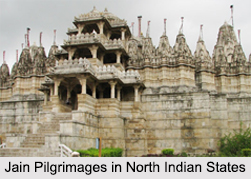 The innumerable Jain temples that dot in North India speak of a myriad intimate association with the lives and activities of the Jain Tirthankaras, who spread the message of peace, non-violence, love and enlightenment. Spread across India, these religious places are some of the best pilgrimage destination in India.
The innumerable Jain temples that dot in North India speak of a myriad intimate association with the lives and activities of the Jain Tirthankaras, who spread the message of peace, non-violence, love and enlightenment. Spread across India, these religious places are some of the best pilgrimage destination in India.
Jain Pilgrimages in North Indian States
The Jain Dilwara temples of India are located about 2 km from Mount Abu, Rajasthan"s only hill station. These temples dating back from the 11th to the 13th century AD are world famous for their stunning use of marble. The carving of the white marble is so delicate that it is almost translucent. The 5 legendary marble temples of Dilwara are the sacred pilgrimage of the Jain Bhagwan. The temples reside amidst mesmerizing surroundings of mango trees and wooded hills.
Ranakpur in the state of Rajasthan is one of the 5 most important pilgrimage sites of Jainism. It is home to an exceptionally beautiful temple complex in the Aravalli ranges and a must visit for the tourists coming to this region.
The Jain Golden Temple in Falna, a small town in Rajasthan has a unique attraction worldwide. It is the first temple that has been constructed by the people of the Jain community. The specialty of the temple is that, from the Falna town itself about 90 kg of gold was donated by the ladies of the Jain community for the idolization of temple dome and Lords idol. Falna is famous for some marvellous carved Jain temples constructed during the regime of Rana Kumbha of Mewar in 1439 AD. Falna Jain Golden temple is ranked among the 5 holiest pilgrimage center of the Jain religion, remarkable in its architecture splendour and beauty.
Tijara Jain temple is one of the famous Jain temples situated in town Tijara of Alwar district, Rajasthan. The Nasiyan Digambar Jain Temple is located in Ajmer on Prithviraj Marg. It is also popularly known as the "Red Temple". The Sri Digambar Jain Lal Mandir is an ancient temple dedicated to the 23rd Tirthankara, Lord Parshvanatha and is known as the oldest Jain Temple in Delhi that lies opposite to the famous Red Fort.




















